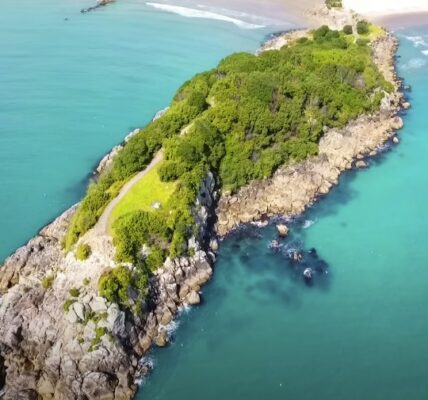Mount Maunganui, often affectionately referred to as “The Mount” by locals, is one of New Zealand’s most beloved landmarks. Located in the coastal city of Tauranga, Bay of Plenty, it offers spectacular views and a great exercise opportunity. If you’re planning a trip and wondering “how many kms up Mount Maunganui?”, this article will provide you with all the necessary details to prepare for your ascent.
Quick Facts About Mount Maunganui
Mount Maunganui, located in Tauranga, Bay of Plenty, New Zealand, is a popular destination for outdoor enthusiasts. Here are some key details about this iconic landmark:
| Location | Mount Maunganui is situated in Tauranga, Bay of Plenty, New Zealand. It is a prominent feature of the landscape, offering stunning views of the surrounding area. |
| Height | Standing tall at 232 meters above sea level, Mount Maunganui provides an impressive vantage point for panoramic views of the coastline and beyond. |
| Type of Hike | The hike up Mount Maunganui is categorized as a walk/hike, suitable for individuals of varying fitness levels. While it presents some challenges, it is accessible to most hikers. |
| Difficulty | The difficulty level of the Mount Maunganui hike is considered moderate. While it may not be overly strenuous, there are sections that require a moderate level of physical exertion. |
| Trail Type | The trail up Mount Maunganui follows a loop format, allowing hikers to ascend and descend via different paths. This loop configuration provides variety and scenic viewpoints along the way. |
| Distance | The total distance of the Mount Maunganui hike is approximately 3.4 kilometers for a return trip. Hikers can expect a manageable distance with opportunities to rest and take in the surroundings. |
| Average Walking Time | On average, it takes about 1.5 hours to complete the round trip hike up Mount Maunganui. However, actual walking times may vary depending on individual fitness levels, rest breaks, and time spent enjoying the views. |
What to Expect When Walking Up Mount Maunganui
Walking up Mount Maunganui is an invigorating experience that combines physical challenge with panoramic rewards. The trail, though varying in steepness, is well-maintained, ensuring safety and accessibility for hikers of different fitness levels.
Trail Details
The journey from the base to the summit of Mount Maunganui spans approximately 1.7 kilometers one way. While the distance may seem short, the elevation gain is significant, totaling around 180 meters from the base to the summit.
The surface of the trail predominantly consists of paved pathways, offering stability underfoot. However, there are sections along the route that feature natural rock and dirt paths, adding an element of adventure to the hike.
Experience Along the Trail
As you embark on the ascent, you’ll encounter various highlights that enhance the overall hiking experience:
- Scenic Lookouts: Throughout the trail, several vantage points provide breathtaking views of Tauranga, the Pacific Ocean, and the distant coastline. These opportunities allow hikers to pause, catch their breath, and immerse themselves in the natural beauty surrounding Mount Maunganui;
- Flora and Fauna: The diverse ecosystem of Mount Maunganui is home to a plethora of native plants and birds. Keep a keen eye out for the iconic pohutukawa trees, especially during their blooming season when they adorn the landscape with vibrant red blooms. Additionally, you may encounter native bird species such as tui and kereru, adding an auditory and visual delight to your hike;
- Summit Views: Upon reaching the summit, a rewarding panorama awaits. 360-degree views stretch out before you, showcasing the picturesque harbor, pristine beaches, and the bustling town of Tauranga. The sense of accomplishment coupled with the awe-inspiring vistas makes the ascent well worth the effort.
Preparing for Your Hike

Before you start the hike up Mount Maunganui, here are some preparation tips to ensure a safe and enjoyable experience:
Footwear
The right footwear is crucial for a successful hike. Opt for sturdy, comfortable walking or hiking shoes that provide good ankle support and traction. Ill-fitting or unsuitable footwear can lead to discomfort, blisters, or even injuries during the hike. Here’s a breakdown of suitable footwear options:
| Footwear Type | Description |
|---|---|
| Hiking Boots | Provides excellent ankle support and traction on rugged terrain. Ideal for longer or steep hikes. |
| Trail Running Shoes | Lightweight and flexible, suitable for shorter hikes on well-maintained trails. |
| Walking Shoes | Comfortable and supportive for casual hikes on less challenging terrain. |
Ensure your footwear is broken in before the hike to prevent discomfort or blisters during the journey. Consider wearing moisture-wicking socks to keep your feet dry and prevent friction.
Clothing
The weather on Mount Maunganui can be unpredictable, so dressing in layers is advisable. This allows you to adjust your clothing according to changing temperatures and weather conditions throughout the hike. Here’s a suggested layering system:
- Base Layer: Moisture-wicking material to keep you dry and comfortable;
- Mid Layer: Insulating layer to retain body heat in cooler conditions;
- Outer Layer: Waterproof and windproof jacket to protect against rain and wind.
Additionally, choose lightweight, breathable fabrics that dry quickly and provide UV protection. Avoid cotton clothing, as it retains moisture and can lead to discomfort if you sweat or encounter rain.
Water
Staying hydrated is essential, especially during strenuous physical activity like hiking. Be sure to bring an adequate supply of water to sustain you throughout the hike, particularly in the warmer summer months. A hydration pack or water bottles are convenient options for carrying water. Aim to drink regularly to prevent dehydration. The following table outlines recommended water intake based on duration and intensity of the hike:
| Hike Duration | Recommended Water Intake |
|---|---|
| Short Hikes | 500ml – 1 liter |
| Half-Day Hikes | 1 – 2 liters |
| Full-Day Hikes | 2 – 4 liters |
| Strenuous Hikes | 4 liters or more, depending on weather conditions |
It’s essential to listen to your body and drink water even before you feel thirsty to maintain hydration levels.
Sun Protection
Mount Maunganui is often exposed to strong sunlight, so adequate sun protection is vital to prevent sunburn and sun damage. Before setting off on your hike, ensure you have the following sun protection essentials:
- Sunscreen: Apply a broad-spectrum sunscreen with a high SPF rating to all exposed skin, including your face, neck, arms, and legs. Reapply every few hours, especially if sweating or swimming;
- Hat: Wear a wide-brimmed hat to shade your face, neck, and ears from direct sunlight;
- Sunglasses: Invest in sunglasses with UV protection to shield your eyes from harmful UV rays and reduce glare.
Consider wearing lightweight, breathable clothing that covers your skin to minimize exposure to the sun’s rays.
Time of Day
The timing of your hike can significantly impact your experience, particularly in hot and sunny conditions. To avoid the midday heat and harsh sunlight, consider starting your hike early in the morning or late in the afternoon when temperatures are cooler. This also offers the opportunity to witness stunning sunrise or sunset views from the summit.
Plan your hike according to your fitness level and the estimated duration of the journey. Allow extra time for breaks, rest stops, and taking in the scenery along the trail.
Safety Considerations
When embarking on a hiking trip, safety should always be the top priority. This includes being well-prepared for various conditions and terrain challenges. Here are some key safety considerations to keep in mind, focusing on weather, physical fitness, and staying on designated paths.
Weather Conditions
Checking the weather forecast before starting your hike is crucial. Weather can greatly affect trail conditions and your overall safety. Some important points to consider:
- Wet Conditions: Trails can become slippery, increasing the risk of slips and falls. Wear appropriate footwear with good traction and use trekking poles for stability;
- Extreme Heat: Stay hydrated by carrying an adequate supply of water. Wear lightweight, breathable clothing, and consider hiking early in the morning or late in the evening to avoid peak heat;
- Cold Temperatures: Dress in layers to regulate body temperature. Carry extra clothing, including a waterproof jacket, hat, and gloves. Be aware of signs of hypothermia and frostbite.
Physical Fitness
Being aware of your physical limitations is essential for a safe hiking experience. Hiking trails can vary in difficulty, with some involving steep ascents or long distances. Consider the following:
- Know Your Limits: Choose trails that match your fitness level and experience. If you’re a beginner, start with shorter, easier trails before tackling more challenging ones;
- Train Appropriately: Incorporate cardiovascular and strength training exercises into your fitness routine to improve endurance and muscle strength;
- Take Breaks: Pace yourself during the hike and take regular breaks to rest and hydrate. Listen to your body and don’t push yourself beyond your capabilities.
Staying on Designated Trails
Straying off marked trails not only poses a safety risk to hikers but also harms the environment. It can lead to erosion, damage to vegetation, and disturbance to wildlife habitats. Here’s why it’s important to stay on the designated path:
- Safety: Marked trails are established based on safety considerations and are regularly maintained. Venturing off-trail increases the likelihood of getting lost or encountering hazards such as unstable terrain or dangerous wildlife;
- Environmental Protection: By sticking to designated trails, you minimize your impact on the surrounding ecosystem. Avoid trampling on fragile vegetation or disturbing wildlife habitats;
- Respect for Regulations: Many hiking areas have specific rules and regulations in place to protect the environment and ensure visitor safety. By staying on marked trails, you demonstrate respect for these guidelines and contribute to the preservation of natural areas.
Conclusion
Mount Maunganui is not only a test of endurance but also a rewarding journey with breathtaking views. Knowing “how many kms up Mount Maunganui?” helps you prepare adequately for what is undoubtedly one of New Zealand’s most scenic hikes. Whether you’re a local or a tourist, the trek to the summit is an unforgettable experience, combining natural beauty with a sense of accomplishment upon reaching the top. So lace up your hiking boots and get ready for an adventure that encapsulates the essence of New Zealand’s outdoor charm!
FAQ
It typically takes about 45 minutes to ascend and slightly less to descend, depending on your pace and fitness level.
Yes, children can enjoy the hike, but supervision is necessary due to some steep and rocky parts.
Dogs are allowed but must be kept on a leash at all times to respect wildlife and other hikers.
The trail is accessible year-round, but spring and autumn offer the most pleasant temperatures and scenery.
There are no facilities at the summit, so ensure you carry everything you need with you.






